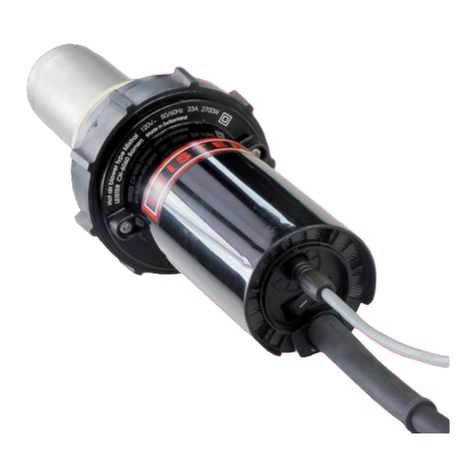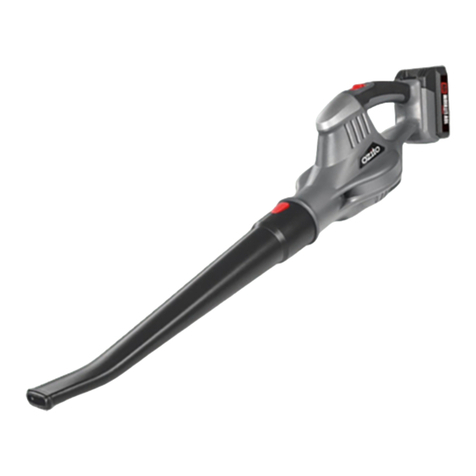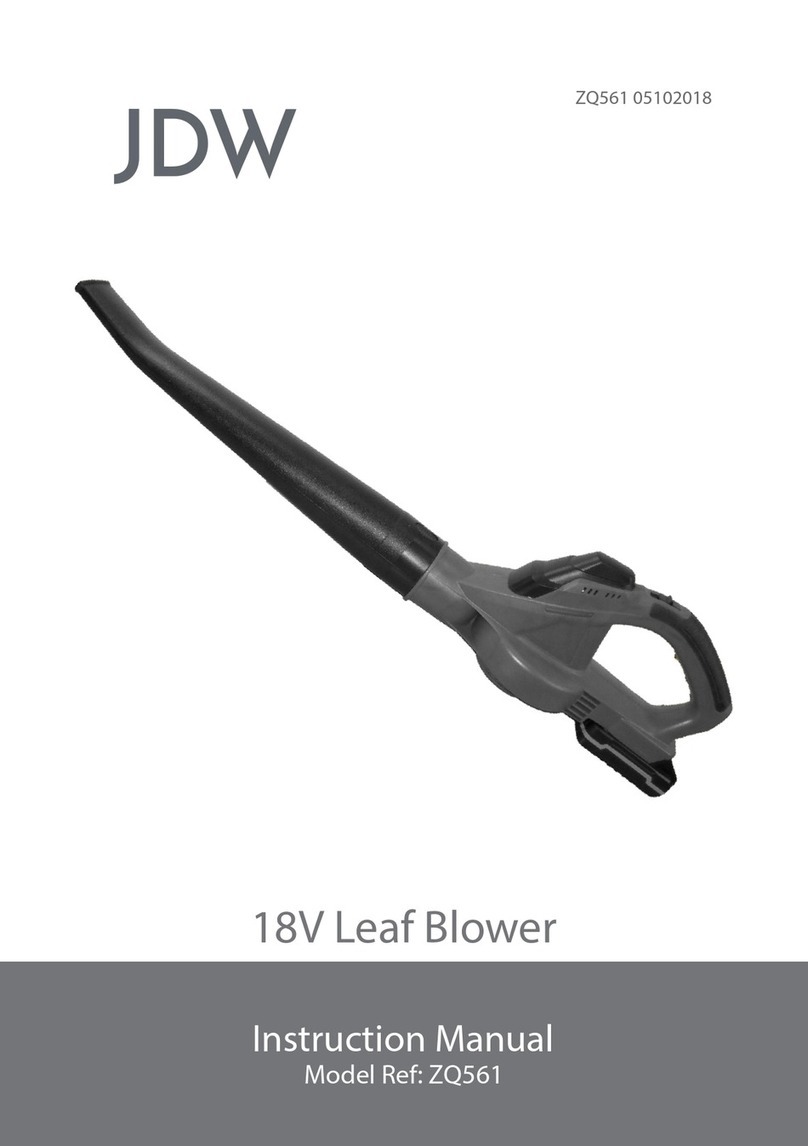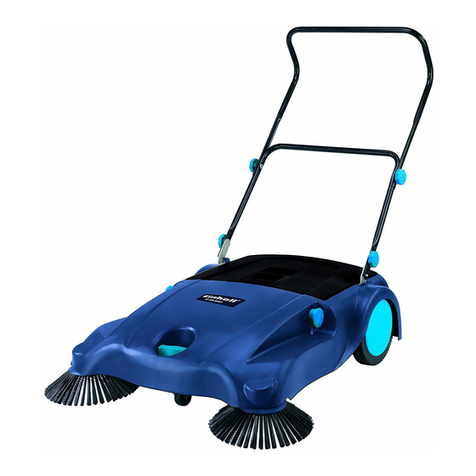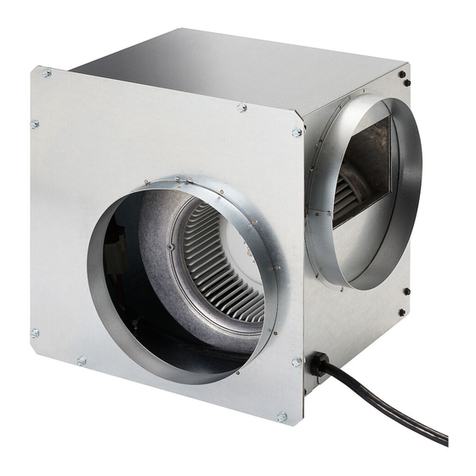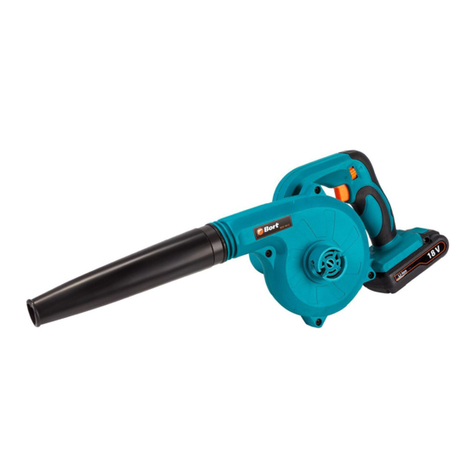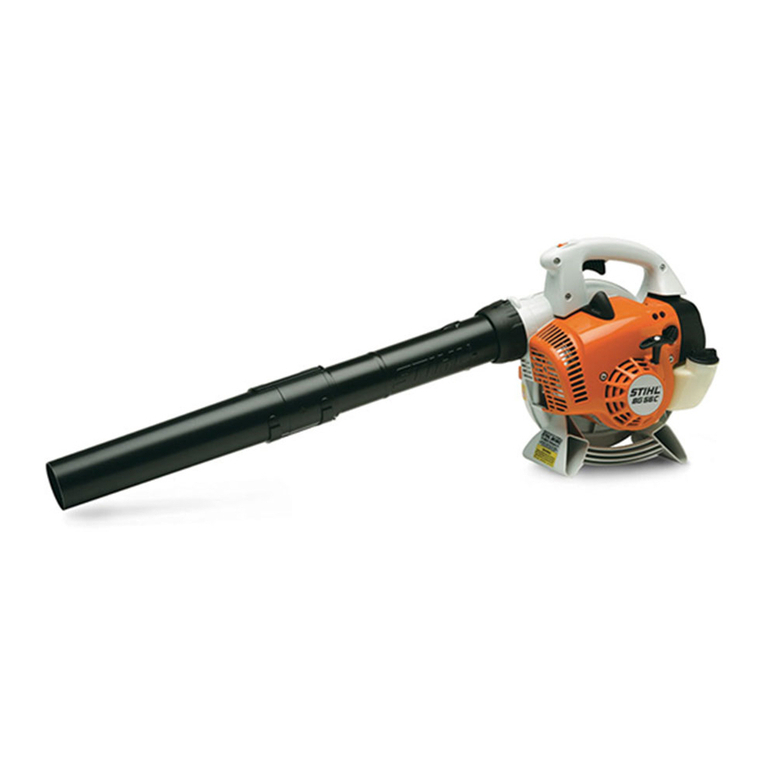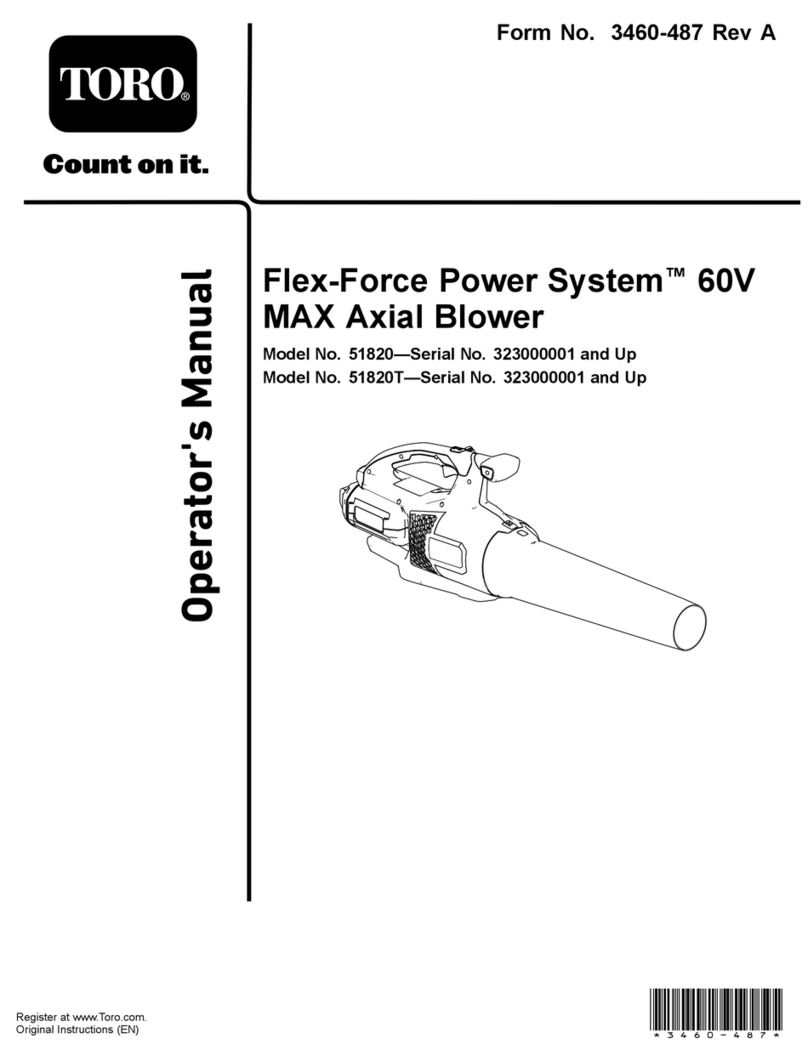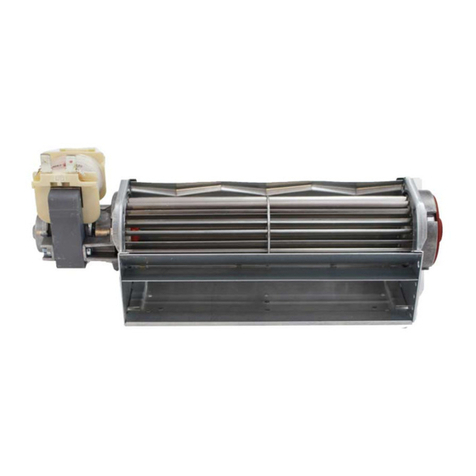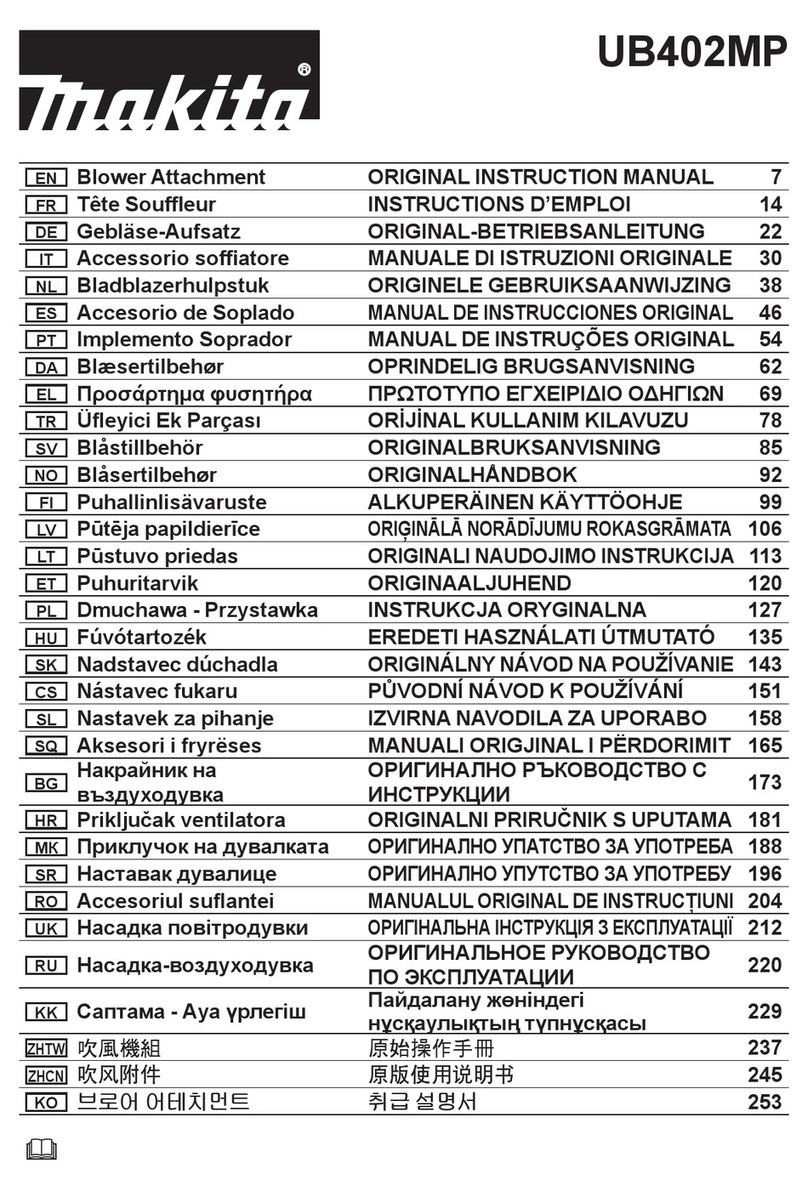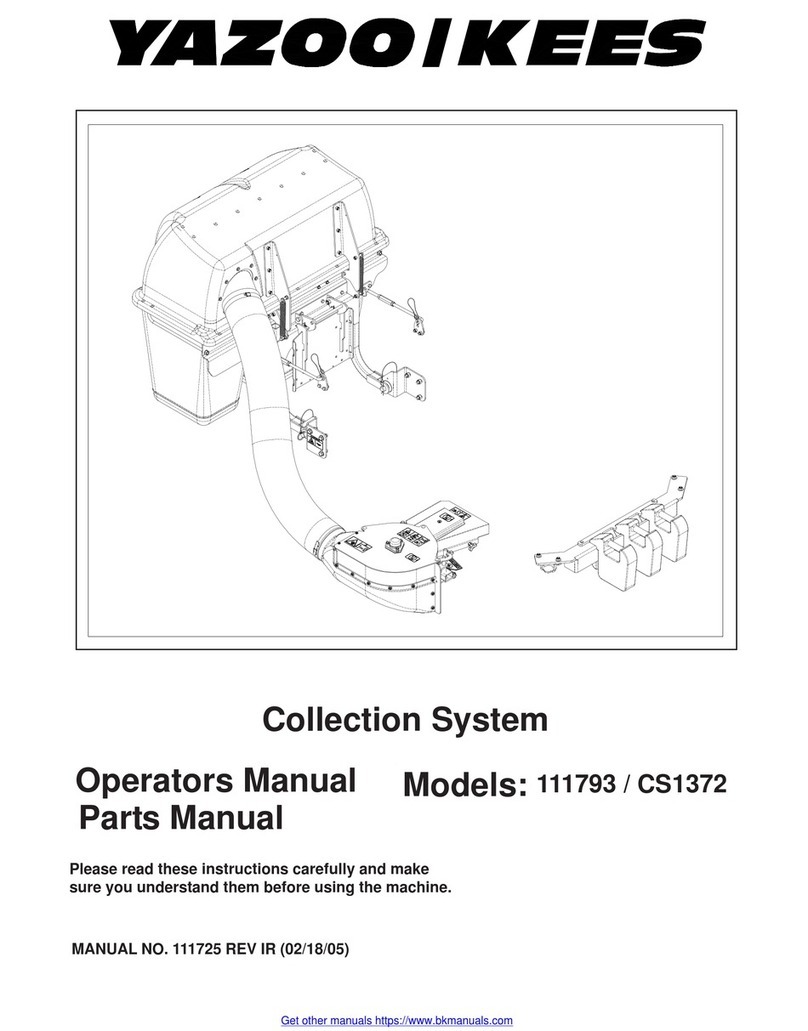Cramer 2400986 User manual

2400986 (82B26)
EN | DE | ES | IT | FR | PT | NL | RU | FI || SV |
| NO|
| DA |
PL | CS | SK | SL| HR| HU | RO| BG| EL || AR |
| TR |
| HE |
LT | LV | ET | MK| SR |
cramertools.com
P0804008-00 Rev B1


Name and address of the manufacturer:
Name: GLOBGRO AB
Address: Riggaregatan 53, 211 13 Malmö Sweden
Name and address of the Authorized representative:
Name: Garden Equipment Ltd
Address: 3a Groveley Road, Christchurch, Dorset, BH23 3HB, UK
Name and address of the person authorised to compile the technical file:
Name: Simon Del-Nevo
Address: 3a Groveley Road, Christchurch, Dorset, BH23 3HB, UK
Here with we declare that the product
Category: Blower
Model: 82B26 (BLB494)
Serial number: See product rating label
Year of Construction: See product rating label
• Is in conformity with the relevant provisions of the Supply of Machinery (Safety) Regulations 2008.
• Is in conformity with the provisions of the following other UK legislation:
• Electromagnetic Compatibility Regulations 2016
• Noise Emission in the Environment by Equipment for use Outdoors Regulations 2001
• The Restriction of the Use of Certain Hazardous Substances in Electrical and Electronic
Equipment Regulations 2012
Furthermore, we declare that the following standard have been used:
Conformity assessment method to Annex E Noise Emission in the Environment by Equipment for
use Outdoors Regulations 2001.
Measured sound power level 106 dB(A)
Guaranteed sound power level 109 dB(A)
Place, date: Christchurch, Dorset, UK 07.06.2021 Signature: Ted Qu, Quality Director
DECLARATION OF CONFORMITY (UK)
EN 60335-1, EN 50636-2-100,EN 62233,EN 55014-1,EN 55014-2,
EN ISO 3744, ISO 11094, IEC 62321-3-1,IEC 62321-4,IEC 62321-5,
IEC 62321-6, IEC 62321-7-1, IEC 62321-7-2,IEC 62321-8
Globe Group Europe

1 Description.........................................5
1.1 Purpose.............................................................. 5
1.2 Overview........................................................... 5
2 General safety warnings................... 5
3 Installation......................................... 5
3.1 Unpack the machine.......................................... 5
3.2 Install the trigger handle.................................... 5
3.3 Install the blower tube....................................... 5
3.4 Assemble the tube assembly..............................5
3.5 Install the battery pack.......................................5
3.6 Remove the battery pack................................... 6
3.7 Adjust the harness..............................................6
3.8 Remove the harness........................................... 6
4 Operation........................................... 6
4.1 Start the machine............................................... 6
4.2 Stop the machine............................................... 6
4.3 Cruise control lever........................................... 6
4.4 Turbo button...................................................... 6
4.5 Operation tips.................................................... 6
5 Maintenance.......................................7
5.1 Clean the machine............................................. 7
6 Transportation and storage..............7
6.1 Move the machine............................................. 7
6.2 Store the machine.............................................. 7
7 Troubleshooting.................................7
8 Technical data....................................7
9 EC Declaration of conformity..........7
4
English (Original Instructions)
EN

1 DESCRIPTION
1.1 PURPOSE
The machine is used to propel air out of a tube to move
unwanted materials such as leaves in the yard. This machine
also sucks in leaves and small twigs through a vacuum, and
shreds them into a bag.
1.2 OVERVIEW
Figure 1 - 13.
1Tube
2Trigger
3Cruise control
4Turbo button
5Harness
6Battery life indicator
7Trigger handle
8Connecting tube
9Knob
10 Cord
11 Cord retainer
12 Tube
13 Tube
14 Blower release button
15 Latch
16 Dust cover
17 Battery release button
aGroove
bTab
cLock position
dUpper possition
AChest strap
BHardness strap
CWaist strap
2 GENERAL SAFETY
WARNINGS
WARNING
Read all safety warnings, instructions, illustrations and
specifications provided with this machine. Failure to
follow all instructions listed below may result in electric
shock, fire and/or serious injury.
Save all warnings and instructions for future reference.
The term "power tool" in the warnings refers to your mains-
operated (corded) power tool or battery-operated (cordless)
power tool.
3 INSTALLATION
3.1 UNPACK THE MACHINE
WARNING
Make sure that you correctly assemble the machine before
use.
WARNING
• If parts of the machine are damaged, do not use the
machine.
•If parts are missing, do not operate the machine.
•If parts are damaged or missing, contact the service
center.
1. Open the package.
2. Read the documentation provided in the box.
3. Remove all the unassembled parts from the box.
4. Remove the machine from the box.
5. Discard the box and packing material in compliance with
local regulations.
WARNING
For your personal safety, do not insert battery before the
tool is assembled completely.
3.2 INSTALL THE TRIGGER HANDLE
Figure 2.
1. Slide trigger handle (7) on the connecting tube (8).
2. Move trigger handle to desired location before fully
tightening. Use supplied knob (9) to tighten trigger
handle to the connecting tube.
3. Place the cord (10) in the cord retainer (11).
3.3 INSTALL THE BLOWER TUBE
Figure 3 - 5.
1. Align either of the grooves (a) in tube (12) with the tabs
(b) on tube (8). Turn the tube (12) in the direction of the
arrow until both of the tabs slide into the lock positions
(c).
2. Connect the tube (13) to tube (12). For shorter tube
application, turn rear tube counterclockwise and move
tube to upper position (d).
3.4 ASSEMBLE THE TUBE ASSEMBLY
Figure 6.
The tube assembly can be disconnected from the backpack
assembly.
1. Press the blower release button (14) and pull up to
disconnect the tube assembly from the backpack
assembly.
3.5 INSTALL THE BATTERY PACK
Figure 7.
WARNING
•If the battery pack or charger is damaged, replace the
battery pack or the charger.
• Stop the machine and wait until the motor stops before
you install or remove the battery pack.
• Read and understand the instructions in the battery and
charger manual.
1. Unlock the latches (15) on both sides to release the dust
cover.
5
English (Original Instructions) EN

2. Remove the dust cover (16) to expose the battery
compartment.
3. Align the battery pack with the cavity in the backpack
housing.
4. Insert the battery pack into the backpack housing.
5. Push the battery pack into the backpack until it locks into
place. You will hear a click once it is locked into place.
6. Do not use force when inserting the battery pack. It
should slide into place and click.
NOTE
Please keep the dust cover installed to prevent entry of dust
or water.
NOTE
The blower can hold two batteries, but only one of the
batteries works during operation.
3.6 REMOVE THE BATTERY PACK
Figure 7
1. Push and hold the battery release button.
2. Remove the battery pack from the machine.
3.7 ADJUST THE HARNESS
Figure 8-12.
1. Fit the backpack on your back.
2. Pull the ends of the straps down to tighten the harness.
3. Connect the horizontal chest strap.
4. Pull the end of the chest strap to tighten.
5. Lift the tabs of the adjusters to loosen the straps.
6. Lock the quick-release fastener by pushing it together.
7. Squeeze the hooks to open the quick-release fastener.
NOTE
Install the back pad against your back tightly and safely.
3.8 REMOVE THE HARNESS
1. Open the quick-release fasteners on the chest strap.
2. Loosen the harness straps by lifting the sliding adjusters
and then take off the machine.
WARNING
In the event of imminent danger, quickly remove the
machine. Release the chest strap before you put the machine
on the ground.
4 OPERATION
WARNING
Make sure the blower tube is in position before operation.
4.1 START THE MACHINE
Figure 13.
1. Insert two batteries.
2. Pull the trigger to start the machine.
3. Pull the trigger fully to increase the speed.
4. Release the trigger to decrease the speed.
4.2 STOP THE MACHINE
1. Release the trigger to stop the machine.
NOTE
Wait until the motor stops after you stop the machine.
4.3 CRUISE CONTROL LEVER
Figure 13.
1. Pull the cruise control lever to the "Rabbit" mark side to
increase the speed of the machine.
4.4 TURBO BUTTON
1. Push the turbo button (1)once, the machine is at the
highest speed.
2. Push the turbo button again, the machine is at the normal
speed.
NOTE
Using the turbo button drains the battery the fastest. Only
use the turbo button when needed.
4.5 OPERATION TIPS
• Blow around the outer edge of the unwanted materials to
prevent the unwanted materials from scattering.
• Use rakes and brooms to clear the unwanted material
before you blow.
• Make the surfaces wet before you clear the unwanted
material in dusty conditions.
• Look out for children, pets, open windows, and cleaned
cars during operation.
• Clean the machine.
• Discard the unwanted material when you complete work.
6
English (Original Instructions)
EN

5 MAINTENANCE
CAUTION
Do not let brake fluids, gasoline, petroleum-based materials
touch the plastic parts. Chemicals can cause damage to the
plastic, and make the plastic unserviceable.
CAUTION
Do not use strong solvents or detergents on the plastic
housing or components.
WARNING
Disconnect the plug from the power source before
maintenance.
5.1 CLEAN THE MACHINE
WARNING
The machine must be dry. Humidity can cause risks of
electrical shocks.
• Clear the unwanted material out of the air vent with a
vacuum cleaner.
•Do not spray the air vent or put the air vent in solvents.
• Clean the housing and the plastic components with a
moist and soft cloth.
• Banned washing
6 TRANSPORTATION AND
STORAGE
WARNING
Disconnect the plug from the power source before
tranportation and storage.
6.1 MOVE THE MACHINE
• Only hold the machine with the handgrip.
6.2 STORE THE MACHINE
• Clean the machine before storage.
• Make sure that the motor is not hot when you store the
machine.
•Make sure that the machine does not have loose or
damaged parts. If it is necessary, do these steps/
instructions:
• Replace the damaged parts.
• Tighten the bolts.
• Speak to a person of an approved service center.
• Store the machine in a dry area.
• Make sure that children cannot come near the machine.
7 TROUBLESHOOTING
PROBLEM POSSIBLE
CAUSE
SOLUTION
The motor does
not start when
you pull the trig-
ger.
The battery pack is
not installed tight-
ly.
Make sure that
you tighlty install
the battery pack in
the machine.
The battery pack is
out of power.
Charge the battery
pack.
The machine does
not start.
The power switch
is defective. Replace the defec-
tive parts by an ap-
proved service
center.
The motor is defec-
tive.
The PCB board is
defective.
The air does not
flow through the
tube when you
start the machine.
The air inlet or
tube outlet has a
blockage.
Remove the block-
age.
8 TECHNICAL DATA
Voltage 82 V DC
Air volume 19.5 m³/min
Air speed 313.8 km/h
Weight (without battery pack) 7.2 kg
Measured sound pressure level LPA= 106 dB(A), KPA=
3 dB(A)
Guaranteed sound power level LWA.d= 109 dB(A)
Vibration 1.9 m/s2 , K = 1.5 m/s2
Battery model 82V180, 82V290P,
82V360, 82V580P and
other BAB series
Charger model 82C6 and other CAB
series
IPX IPX4
9 EC DECLARATION OF
CONFORMITY
Name and address of the manufacturer:
Name: GLOBGRO AB
Globe Group Europe
Address: Riggaregatan 53, 211 13 Malmö, Sweden
Name and address of the person authorised to compile the
technical file:
7
English (Original Instructions) EN

Name: Micael Johansson
Address: Riggaregatan 53, 211 13 Malmö, Sweden
Herewith we declare that the product
Category: Blower / Vacuum
Model: 82B26(BLB494)
Serial number: See product rating label
Year of Construction: See product rating label
• is in conformity with the relevant provisions of the
Machinery Directive 2006/42/EC.
• is in conformity with the provisions of the following
other EC-Directives:
•2014/30/EU
• 2000/14/EC & 2005/88/EC
• 2011/65/EU & (EU)2015/863
Furthermore, we declare that the following parts, clauses of
harmonised standards have been used:
• EN 60335-1, EN 50636-2-100, EN 62233, EN 55014-1,
EN 55014-2, EN ISO 3744, ISO 11094, IEC 62321-3-1,
IEC 62321-4, IEC 62321-5, IEC 62321-6, IEC
62321-7-1, IEC 62321-7-2, IEC 62321-8
Conformity assessment method to Annex V / Directive
2000/14/EC.
Measured sound power level: LWA: 106 dB(A)
Guaranteed sound power level: LWA.d: 109 dB(A)
Place, date: Malmö,
09.09.2021
Signature: Ted Qu, Quality
Director
8
English (Original Instructions)
EN

1 Beschreibung....................................10
1.1 Verwendungszweck......................................... 10
1.2 Übersicht..........................................................10
2 Allgemeine Sicherheitshinweise..... 10
3 Montage............................................10
3.1 Maschine auspacken........................................ 10
3.2 Installieren des Auslösergriffs......................... 10
3.3 Das Laubbläserrohr installieren.......................10
3.4 Die Schlauchgruppe montieren....................... 10
3.5 Akkupack einsetzen......................................... 11
3.6 Akkupack entfernen.........................................11
3.7 Einstellen der Riemen......................................11
3.8 Entfernen Sie die Riemen................................ 11
4 Bedienung.........................................11
4.1 Maschine starten.............................................. 11
4.2 Maschine anhalten........................................... 11
4.3 Fahrsteuerhebel................................................11
4.4 Turbotaste........................................................ 11
4.5 Tipps zur Bedienung........................................12
5 Wartung und Instandhaltung.........12
5.1 Maschine reinigen............................................12
6 Transport und Lagerung................ 12
6.1 Maschine transportieren.................................. 12
6.2 Maschine lagern...............................................12
7 Fehlerbehebung...............................12
8 Technische Daten.............................12
9 EG-Konformitätserklärung........... 13
9
Deutsch
DE

1 BESCHREIBUNG
1.1 VERWENDUNGSZWECK
Die Maschine wird verwendet, um Luft aus einem Rohr
auszustoßen, um unerwünschtes Material wie Blätter zu
entfernen. Diese Maschine kann auch Blätter und kleine
Zweige durch einen Unterdruck einsaugen und sie im Beutel
schreddern.
1.2 ÜBERSICHT
Abbildung 1 - 13.
1Rohr
2Auslöser
3Fahrsteuerung
4Turbotaste
5Riemen
6Ladestandsanzeige
7Auslösergriff
8Verbindungsrohr
9Handgriff
10 Kabel
11 Kabelhalter
12 Rohr
13 Rohr
14 Laubbläser-
Entriegelungstaste
15 Riegel
16 Staubschutzhülle
17 Akkupack-
Entriegelungstaste
aKerbe
bLasche
cEinrastposition
dObere Position
ABrustgurt
BGeschirrriemen
CHüftriemen
2 ALLGEMEINE
SICHERHEITSHINWEISE
WARNUNG
Lesen Sie alle Sicherheitshinweise, Anweisungen,
Abbildungen und Spezifikationen, die mit diesem Gerät
geliefert werden. Die Nichtbeachtung der unten
aufgeführten Anweisungen kann zu Stromschlag, Feuer und/
oder schweren Verletzungen führen.
Bewahren Sie alle Sicherheitshinweise und Anweisungen
zur späteren Verwendung auf.
Der Begriff "Elektrowerkzeug" in den Sicherheitshinweisen
bezieht sich auf Ihr netzbetriebenes (kabelgebundenes)
Elektrowerkzeug oder akkubetriebenes (kabelloses)
Elektrowerkzeug.
3 MONTAGE
3.1 MASCHINE AUSPACKEN
WARNUNG
Vergewissern Sie sich, dass Sie die Maschine vor dem
Gebrauch richtig montiert haben.
WARNUNG
•Bei beschädigten Maschinenteilen dürfen Sie die
Maschine nicht verwenden.
• Bei fehlenden Teilen dürfen Sie die Maschine nicht
verwenden.
• Wenn Teile beschädigt sind oder fehlen, wenden Sie
sich an die Servicestelle.
1. Öffnen Sie die Verpackung.
2. Lesen Sie die beiliegende Dokumentation.
3. Entnehmen Sie alle unmontierten Teile aus dem Karton.
4. Nehmen Sie die Maschine aus dem Karton.
5. Entsorgen Sie den Karton und das Verpackungsmaterial
gemäß den örtlichen Vorschriften.
WARNUNG
Zu Ihrer eigenen Sicherheit dürfen Sie den Akkupack nicht
einsetzen, bevor das Werkzeug vollständig
zusammengebaut ist.
3.2 INSTALLIEREN DES
AUSLÖSERGRIFFS
Abbildung 2.
1. Schieben Sie den Auslösergriff (7) auf das
Verbindungsrohr (8).
2. Bringen Sie den Auslösegriff in die gewünschte Position,
bevor Sie ihn vollständig festziehen. Verwenden Sie den
mitgelieferten Knopf (9), um den Auslösegriff am
Verbindungsrohr festzuziehen.
3. Stecken Sie das Kabel (10) in den Kabelhalter (11).
3.3 DAS LAUBBLÄSERROHR
INSTALLIEREN
Abbildung 3 - 5.
1. Richten Sie eine der Kerben (a) im Schlauch (12) an den
Laschen (b) des Schlauchs (8) aus. Drehen Sie den
Schlauch (12) in Pfeilrichtung, bis die beiden Laschen in
die Einrastpositionen (c) rutschen.
2. Verbinden Sie den Schlauch (13) mit Schlauch (12).
Wenn Sie einen kürzeren Schlauch verwenden möchten,
drehen Sie den hinteren Schlauch gegen den
Uhrzeigersinn und bringen Sie den Schlauch in die obere
Position (d).
3.4 DIE SCHLAUCHGRUPPE
MONTIEREN
Abbildung 6.
Die Schlauchgruppe kann von der Rucksackgruppe getrennt
werden.
10
Deutsch
DE

1. Drücken Sie die Laubbläser-Entriegelungstaste (14) und
ziehen Sie nach oben, um die Schlauchgruppe von der
Rucksackgruppe zu trennen.
3.5 AKKUPACK EINSETZEN
Abbildung 7.
WARNUNG
•Wenn der Akkupack oder das Ladegerät beschädigt ist,
ersetzen Sie den Akkupack oder das Ladegerät.
• Stoppen Sie die Maschine und warten Sie, bis der
Motor stoppt, bevor Sie den Akkupack einsetzen oder
entnehmen.
•Lesen und verstehen Sie die Anweisungen im
Handbuch für Akkupack und Ladegerät.
1. Entriegeln Sie die Verriegelungen (15) auf beiden Seiten,
um die Staubschutzhülle zu lösen.
2. Entfernen Sie die Staubschutzhülle (16), um das
Akkufach freizulegen.
3. Richten Sie den Akkupack auf die Aussparung im
Rucksackgehäuse aus.
4. Setzen Sie den Akkupack wieder in das Rucksackgehäuse
ein.
5. Schieben Sie den Akkupack in den Rucksack, bis er
einrastet. Sie hören ein Klicken, sobald es eingerastet ist.
6. Wenden Sie beim Einsetzen des Akkupacks keine Gewalt
an. Es sollte mit einem hörbaren Klicken einrasten.
HINWEIS
Bitte entfernen Sie die Staubschutzhülle nicht, um das
Eindringen von Staub oder Wasser zu verhindern.
HINWEIS
Der Laubbläser kann zwei Akkupacks aufnehmen, aber nur
während des Betriebs wird nur ein Akkupack verwendet.
3.6 AKKUPACK ENTFERNEN
Abbildung 7
1. Drücken und halten Sie die Akkupack-Entriegelungstaste.
2. Nehmen Sie den Akkupack aus der Maschine.
3.7 EINSTELLEN DER RIEMEN
Abbildung 8-12.
1. Nehmen Sie den Rucksack auf den Rücken.
2. Ziehen Sie die Enden der Riemen nach unten, um das
Geschirr festzuziehen.
3. Verbinden Sie den horizontalen Brustriemen.
4. Ziehen Sie am Ende des Brustriemens, um ihn
anzuziehen.
5. Heben Sie die Laschen der Einsteller an, um die Riemen
zu lösen.
6. Sperren Sie die Schnellfreigabebefestigung durch
zusammendrücken.
7. Drücken Sie auf die Haken, um die
Schnellfreigabebefestigung freizugeben.
HINWEIS
Installieren Sie das Rückenpolster fest und sicher an Ihrem
Rücken.
3.8 ENTFERNEN SIE DIE RIEMEN
1. Öffnen Sie die Schnellfreigabebefestiger am Brustriemen.
2. Lösen Sie die Geschirrriemen durch Anheben der
Schiebeeinsteller und nehmen Sie dann die Maschine ab.
WARNUNG
Bei direkter Gefahr schnell die Maschine abnehmen. Den
Brustriemen freigeben, bevor Sie die Maschine auf den
Boden stellen.
4 BEDIENUNG
WARNUNG
Sicherstellen, dass das Laubbläserrohr vor Betrieb in der
richtigen Position eingerastet ist.
4.1 MASCHINE STARTEN
Abbildung 13.
1. Setzen Sie zwei Akkupacks ein.
2. Ziehen Sie den Auslöser, um die Maschine zu starten.
3. Ziehen Sie den Auslöser ganz durch, um die
Geschwindigkeit zu erhöhen.
4. Lassen Sie den Auslöser los, um die Geschwindigkeit zu
verringern.
4.2 MASCHINE ANHALTEN
1. Lassen Sie den Auslöser los, um die Maschine
anzuhalten.
HINWEIS
Warten Sie, bis der Motor anhält, nachdem Sie die
Maschine anhalten.
4.3 FAHRSTEUERHEBEL
Abbildung 13.
1. Ziehen Sie den Fahrsteuerhebel auf die Seite mit dem
"Hasen", um die Maschinengeschwindigkeit zu erhöhen.
4.4 TURBOTASTE
1. Drücken Sie die Turbo-Taste (1) einmal. Die Maschine
läuft mit höchster Geschwindigkeit.
11
Deutsch
DE

2. Lassen Sie die Turbo-Taste wieder los. Die Maschine
läuft mit normaler Geschwindigkeit.
HINWEIS
Die Verwendung der Turbotaste entlädt den Akkupack am
schnellsten. Verwenden Sie die Turbotaste nur bei Bedarf.
4.5 TIPPS ZUR BEDIENUNG
• Blasen Sie von außen nach innen der zu reinigenden
Fläche um zu verhindern, dass das unerwünschte Material
sich verteilt.
• Verwenden Sie Rechen und Besen, um unerwünschtes
Material vor dem Blasen zu lockern.
• Befeuchten Sie staubige Oberflächen, bevor Sie das
unerwünschte Material entfernen.
• Achten Sie im Betrieb auf Kinder, Haustiere, offene
Fenster und Autos.
• Reinigen Sie die Maschine.
• Entsorgen Sie unerwünschtes Material nach Abschluss
der Arbeiten.
5 WARTUNG UND
INSTANDHALTUNG
VORSICHT
Lassen Sie Bremsflüssigkeiten, Benzin und
mineralölbasierte Materialien nicht mit den Kunststoffteilen
in Berührung kommen. Chemikalien können den Kunststoff
beschädigen und ihn unbrauchbar machen.
VORSICHT
Verwenden Sie keine starken Lösungsmittel oder
Reinigungsmittel auf dem Kunststoffgehäuse oder den
Bauteilen.
WARNUNG
Ziehen Sie vor Wartungsarbeiten den Stecker von der
Stromquelle ab.
5.1 MASCHINE REINIGEN
WARNUNG
Die Maschine muss trocken sein. Feuchtigkeit kann zu
einem Stromschlagrisiko führen.
• Entfernen Sie unerwünschtes Material mit einem
Staubsauger aus den Belüftungsöffnungen.
•Sprühen Sie nichts in die Belüftungsöffnungen und
nutzen Sie keine Lösungsmittel.
• Reinigen Sie das Gehäuse und die Kunststoffteile mit
einem feuchten und weichen Tuch.
• Waschen verboten
6 TRANSPORT UND LAGERUNG
WARNUNG
Ziehen Sie vor dem Transport und der Lagerung den
Stecker von der Stromquelle ab.
6.1 MASCHINE TRANSPORTIEREN
• Halten Sie die Maschine nur am Handgriff.
6.2 MASCHINE LAGERN
• Reinigen Sie die Maschine vor der Lagerung.
• Stellen Sie sicher, dass der Motor nicht heiß ist, wenn Sie
die Maschine verstauen.
• Stellen Sie sicher, dass die Maschine keine losen oder
beschädigten Teile aufweist. Wenn es notwendig ist,
führen Sie diese Schritte/Anweisungen aus:
• Tauschen Sie die beschädigten Teile aus.
• Ziehen Sie die Schrauben an.
• Sprechen Sie mit einem Mitarbeiter eines
zugelassenen Servicezentrums.
• Verstauen Sie die Maschine an einem trockenen Ort.
• Stellen Sie sicher, dass Kinder nicht in die Nähe der
Maschine kommen können.
7 FEHLERBEHEBUNG
PROBLEM MÖGLICHE
URSACHE
LÖSUNG
Der Motor startet
nicht, wenn Sie
den Auslöser zie-
hen.
Der Akkupack ist
nicht korrekt einge-
setzt.
Stellen Sie sicher,
dass der Akkupack
fest in der Ma-
schine installiert
wurde.
Der Akkupack ist
leer.
Laden Sie den Ak-
kupack auf.
Die Maschine
startet nicht.
Der Ein/Aus-Schal-
ter ist beschädigt. Lassen Sie die be-
schädigten Teile
durch ein zugelas-
senes Servicecen-
ter ersetzen.
Der Motor ist de-
fekt.
Die PCB-Platine ist
defekt.
Die Luft fließt
nicht durch das
Rohr, wenn Sie
die Maschine ein-
schalten.
Der Lufteinlass
oder Rohrauslass
ist blockiert.
Entfernen Sie die
Blockade.
8 TECHNISCHE DATEN
Spannung 82 V DC
Luftvolumen 19.5 m³/min
12
Deutsch
DE

Luftgeschwindigkeit 313.8 km/h
Gewicht (ohne Akkupack) 7.2 kg
Gemessener Schalldruckpegel LPA= 106 dB(A), KPA=
3 dB(A)
Garantierter Schallleistungspegel LWA.d= 109 dB(A)
Vibration 1.9 m/s2, K = 1.5 m/s2
Akku-Modell 82V180, 82V290P,
82V360, 82V580P und
andere BAB-Baurei-
hen
Ladegerät-Modell 82C6 und andere
CAB-Baureihen
IPX IPX4
9 EG-
KONFORMITÄTSERKLÄRUNG
Name und Anschrift des Herstellers:
Name: GLOBGRO AB
Globe Group Europe
Adresse: Riggaregatan 53, 211 13 Malmö, Schweden
Name und Anschrift der Person, die zur Erstellung der
technischen Unterlagen berechtigt ist:
Name: Micael Johansson
Adresse: Riggaregatan 53, 211 13 Malmö, Schweden
Hiermit erklären wir, dass das Produkt
Kategorie: Laubbläser / -Sauger
Modell: 82B26(BLB494)
Seriennummer: Siehe Produktetikett
Baujahr: Siehe Produktetikett
• den einschlägigen Bestimmungen der Maschinenrichtlinie
2006/42/EG entspricht.
•den Bestimmungen der folgenden anderen EG-
Richtlinien entspricht:
•2014/30/EU
• 2000/14/EG & 2005/88/EG
• 2011/65/EU & 2015/863/EU
Darüber hinaus erklären wir, dass die folgenden Teile/
Klauseln von harmonisierten Normen verwendet wurden:
• EN 60335-1, EN 50636-2-100, EN 62233, EN 55014-1,
EN 55014-2, EN ISO 3744, ISO 11094, IEC 62321-3-1,
IEC 62321-4, IEC 62321-5, IEC 62321-6, IEC
62321-7-1, IEC 62321-7-2, IEC 62321-8
Konformitätsbewertungsmethode nach Anhang V/ der
Richtlinie 2000/14/EG.
Gemessener Schallleistungspegel: LWA: 106 dB(A)
Garantierter Schallleistungspegel: LWA.d: 109 dB(A)
Ort, Datum: Malmö,
09.09.2021
Unterschrift: Ted Qu, Quali-
tätsleiter
13
Deutsch
DE

1 Descripción.......................................15
1.1 Finalidad.......................................................... 15
1.2 Perspectiva general.......................................... 15
2 Advertencias generales de
seguridad .........................................15
3 Instalación........................................15
3.1 Desembalaje de la máquina............................. 15
3.2 Instalación del asa del gatillo...........................15
3.3 Instalación del tubo soplador........................... 15
3.4 Montaje del conjunto del tubo......................... 15
3.5 Instalación de la batería................................... 15
3.6 Retirada de la batería....................................... 16
3.7 Ajuste del arnés............................................... 16
3.8 Retirada del arnés............................................ 16
4 Funcionamiento...............................16
4.1 Puesta en marcha de la máquina......................16
4.2 Detención de la máquina................................. 16
4.3 Palanca de control de crucero.......................... 16
4.4 Botón turbo...................................................... 16
4.5 Consejos de funcionamiento............................17
5 Mantenimiento.................................17
5.1 Limpieza de la máquina...................................17
6 Transporte y almacenamiento........17
6.1 Traslado de la máquina....................................17
6.2 Almacenamiento de la máquina...................... 17
7 Solución de problemas.................... 17
8 Datos técnicos.................................. 17
9 Declaración de conformidad CE....18
14
Español
ES

1 DESCRIPCIÓN
1.1 FINALIDAD
La máquina se utiliza para expulsar aire por un tubo para
eliminar materiales no deseados, como hojas en el patio. Esta
máquina también aspira hojas y ramitas mediante vacío y las
tritura en una bolsa.
1.2 PERSPECTIVA GENERAL
Figura 1 - 13.
1Tubo
2Gatillo
3Control de crucero
4Botón turbo
5Arnés
6Indicador de duración
de la batería
7Asa del gatillo
8Tubo de conexión
9Mando
10 Cable
11 Retención del cable
12 Tubo
13 Tubo
14 Botón de desbloqueo
del soplador
15 Cierre
16 Cubierta antipolvo
17 Botón de desbloqueo
de la batería
aRanura
bPestaña
cPosición de bloqueo
dPosición superior
ACorrea de pecho
BCorrea del arnés
CCorrea de cintura
2 ADVERTENCIAS GENERALES
DE SEGURIDAD
AVISO
Lea todas las advertencias de seguridad, instrucciones,
ilustraciones y especificaciones que se proporcionan con
esta máquina. El incumplimiento de las instrucciones
indicadas a continuación puede provocar descargas
eléctricas, incendios o lesiones graves.
Guarde todas las advertencias e instrucciones para su
consulta posterior.
El término "herramienta eléctrica" empleado en las
advertencias se refiere a su herramienta eléctrica con
funcionamiento de red (con cable) o herramienta eléctrica
con funcionamiento a batería (inalámbrica).
3 INSTALACIÓN
3.1 DESEMBALAJE DE LA MÁQUINA
AVISO
Asegúrese de montar correctamente la máquina antes del
uso.
AVISO
• Si las piezas de la máquina presentan daños, no utilice
la máquina.
• Si faltan piezas, no haga funcionar la máquina.
• Si faltan piezas o hay piezas dañadas, contacte con el
centro de servicio.
1. Abra el embalaje.
2. Lea la documentación que se proporciona en la caja.
3. Retire todas las piezas sin montar de la caja.
4. Retire la máquina de la caja.
5. Deseche la caja y el material de embalaje de conformidad
con los reglamentos locales.
AVISO
Por su seguridad personal, no inserte la batería antes de
haber montado la herramienta por completo.
3.2 INSTALACIÓN DEL ASA DEL
GATILLO
Figura 2.
1. Deslice el asa del gatillo (7) en el tubo de conexión (8).
2. Mueva el asa del gatillo a la posición deseada antes de
apretar por completo. Utilice el mando suministrado (9)
para apretar el asa del gatillo en el tubo de conexión.
3. Coloque el cable (10) en la retención del cable (11).
3.3 INSTALACIÓN DEL TUBO
SOPLADOR
Figura 3 - 5.
1. Alinee cualquiera de las ranuras (a) del tubo (12) con las
pestañas (b) del tubo (8). Gire el tubo (12) en la dirección
de la flecha hasta que ambas pestañas se deslicen en sus
posiciones de bloqueo (c).
2. Conecte el tubo (13) al tubo (12). Para una aplicación de
tubo más corto, gire el tubo trasero en sentido antihorario
y mueva el tubo a la posición superior (d).
3.4 MONTAJE DEL CONJUNTO DEL
TUBO
Figura 6.
El conjunto del tubo puede desconectarse del conjunto de la
mochila.
1. Pulse el botón de desbloqueo del soplador (14) y tire
hacia arriba para desconectar el conjunto del tubo del
conjunto de la mochila.
3.5 INSTALACIÓN DE LA BATERÍA
Figura 7.
15
Español
ES

AVISO
•Si la batería o el cargador ha sufrido daños, sustituya la
batería o el cargador.
• Detenga la máquina y espere hasta que el motor se pare
antes de instalar o retirar la batería.
• Debe leer y entender las instrucciones del manual de la
batería y el cargador.
1. Desbloquee los cierres (15) a ambos lados para soltar la
cubierta antipolvo.
2. Retire la cubierta antipolvo (16) para dejar al descubierto
el compartimento de la batería.
3. Alinee la batería con la cavidad en la carcasa de la
mochila.
4. Inserte la batería en la carcasa de la mochila.
5. Introduzca la batería en la mochila hasta que encaje en su
posición. Debe escuchar un clic cuando esté bloqueada en
su posición.
6. No emplee la fuerza al insertar la batería. Debe deslizarse
en su posición y encajar.
NOTA
Mantenga instalada la cubierta antipolvo para evitar la
entrada de polvo o agua.
NOTA
El soplador puede albergar dos baterías, pero solo una de las
baterías funciona durante el uso.
3.6 RETIRADA DE LA BATERÍA
Figura 7
1. Pulse y mantenga pulsado el botón de desbloqueo de la
batería.
2. Retire la batería de la máquina.
3.7 AJUSTE DEL ARNÉS
Figura 8-12.
1. Póngase la mochila en la espalda.
2. Tire de los extremos de las correas hacia abajo para
apretar el arnés.
3. Conecte la correa del pecho horizontal.
4. Tire del extremo de la correa del pecho para apretar.
5. Levante las pestañas de los ajustadores para aflojar las
correas.
6. Para cerrar el cierre de apertura rápida introduzca los dos
extremos.
7. Para abrir el cierre de apertura rápida apriete los ganchos.
NOTA
Instale la almohadilla trasera contra su espalda firmemente
y con seguridad.
3.8 RETIRADA DEL ARNÉS
1. Abra los cierres de apertura rápida de la correa del pecho.
2. Afloje las correas del arnés levantando los ajustadores
deslizantes y posteriormente saque la máquina.
AVISO
En caso de peligro inminente, retire rápidamente la
máquina. Suelte la correa del pecho antes de poner la
máquina en el suelo.
4 FUNCIONAMIENTO
AVISO
Asegúrese de que el tubo soplador esté en posición antes del
funcionamiento.
4.1 PUESTA EN MARCHA DE LA
MÁQUINA
Figura 13.
1. Inserte dos baterías.
2. Apriete el gatillo para poner en marcha la máquina.
3. Apriete el gatillo a fondo para aumentar la velocidad.
4. Suelte el gatillo para disminuir la velocidad.
4.2 DETENCIÓN DE LA MÁQUINA
1. Suelte el gatillo para detener la máquina.
NOTA
Espere hasta que el motor se detenga tras detener la
máquina.
4.3 PALANCA DE CONTROL DE
CRUCERO
Figura 13.
1. Tire de la palanca de control de crucero hacia el lado de
la marca "Conejo" para aumentar la velocidad de la
máquina.
4.4 BOTÓN TURBO
1. Pulse el botón turbo (1) una vez, la máquina está a la
velocidad más alta.
2. Pulse el botón turbo de nuevo, la máquina está a la
velocidad normal.
NOTA
La utilización del botón turbo agota la batería más
rápidamente. Utilice únicamente el botón turbo cuando sea
necesario.
16
Español
ES

4.5 CONSEJOS DE
FUNCIONAMIENTO
•Sople alrededor del borde exterior de los materiales no
deseados para evitar que estos se dispersen.
• Utilice rastrillos y escobas para quitar el material no
deseado antes de soplar.
• Humedezca las superficies antes de quitar el material no
deseado en condiciones de polvo.
• Tenga cuidado con los niños, las mascotas, las ventanas
abiertas y los coches limpios durante el funcionamiento.
• Limpie la máquina.
• Deseche el material no deseado cuando finalice el trabajo.
5 MANTENIMIENTO
PRECAUCIÓN
No permita que líquidos de frenos, gasolina y otros
derivados del petróleo toquen las piezas de plástico. Las
sustancias químicas pueden dañar el plástico y hacer que
quede inservible.
PRECAUCIÓN
No utilice disolventes o detergentes fuertes en la carcasa o
los componentes de plástico.
AVISO
Desconecte el enchufe de la fuente de alimentación antes
del mantenimiento.
5.1 LIMPIEZA DE LA MÁQUINA
AVISO
La máquina debe estar seca. La humedad supone un riesgo
de descargas eléctricas.
• Quite el material no deseado del respiradero con un
aspirador.
•No pulverice el respiradero ni lo introduzca en
disolventes.
• Limpie la carcasa y los componentes de plástico con un
paño húmedo y suave.
• Lavado prohibido
6 TRANSPORTE Y
ALMACENAMIENTO
AVISO
Desconecte el enchufe de la fuente de alimentación antes
del transporte y el almacenamiento.
6.1 TRASLADO DE LA MÁQUINA
• Sujete la máquina únicamente por la empuñadura.
6.2 ALMACENAMIENTO DE LA
MÁQUINA
• Limpie la máquina antes del almacenamiento.
•Asegúrese de que el motor no esté caliente cuando
almacene la máquina.
• Asegúrese de que la máquina no tenga piezas sueltas o
dañadas. Si es necesario, siga estos pasos/estas
instrucciones:
• Sustituya las piezas dañadas.
• Apriete los pernos.
• Hable con una persona de un centro de servicio
aprobado.
• Almacene la máquina en una zona seca.
• Asegúrese de que los niños no puedan acercarse a la
máquina.
7 SOLUCIÓN DE PROBLEMAS
PROBLEMA POSIBLE CAU-
SA
SOLUCIÓN
El motor no se
pone en marcha
cuando aprieta el
gatillo.
La batería no se ha
instalado bien.
Asegúrese de que
ha instalado bien
la batería en la má-
quina.
La batería se ha
agotado. Cargue la batería.
La máquina no se
pone en marcha.
El interruptor de
encendido está de-
fectuoso. Las piezas defec-
tuosas deben ser
sustituidas por un
centro de servicio
autorizado.
El motor está de-
fectuoso.
La placa de circui-
tos impresos está
defectuosa.
El aire no fluye
por el tubo cuan-
do pone en
marcha la máqui-
na.
La entrada de aire
o la salida del tubo
tiene una obstruc-
ción.
Elimine la obstruc-
ción.
8 DATOS TÉCNICOS
Tensión 82 V CC
Volumen de aire 19.5 m³/min
Velocidad de aire 313.8 km/h
Peso (sin batería) 7.2 kg
Nivel de presión acústica medida LPA= 106 dB(A), KPA=
3 dB(A)
Nivel de potencia acústica garanti-
zada
LWA.d= 109 dB(A)
17
Español
ES

Vibración 1.9 m/s2, K = 1.5 m/s2
Modelo de batería 82V180, 82V290P,
82V360, 82V580P y
otras series BAB
Modelo de cargador 82C6 y otras series
CAB
IPX IPX4
9 DECLARACIÓN DE
CONFORMIDAD CE
Nombre y dirección del fabricante:
Nombre: GLOBGRO AB
Globe Group Europe
Dirección: Riggaregatan 53, 211 13 Malmö, Suecia
Nombre y dirección de la persona autorizada para compilar el
archivo técnico:
Nombre: Micael Johansson
Dirección: Riggaregatan 53, 211 13 Malmö, Suecia
Por la presente declaramos que el producto
Categoría: Soplador / Aspirador
Modelo: 82B26(BLB494)
Número de serie: Véase la etiqueta de clasifi-
cación del producto
Año de construcción: Véase la etiqueta de clasifi-
cación del producto
• es conforme con las disposiciones pertinentes de la
Directiva relativa a las máquinas (2006/42/CE).
•es conforme con las disposiciones de las siguientes
Directivas CE:
•2014/30/UE
• 2000/14/CE y 2005/88/CE
• 2011/65/UE y 2015/863/UE
Adicionalmente, declaramos que se han utilizado las
siguientes partes o cláusulas de las normas armonizadas:
• EN 60335-1, EN 50636-2-100, EN 62233, EN 55014-1,
EN 55014-2, EN ISO 3744, ISO 11094, IEC 62321-3-1,
IEC 62321-4, IEC 62321-5, IEC 62321-6, IEC
62321-7-1, IEC 62321-7-2, IEC 62321-8
Método de evaluación de conformidad según el anexo V /
Directiva 2000/14/CE.
Nivel de potencia acústica medida: LWA: 106 dB(A)
Nivel de potencia acústica garanti-
zada:
LWA.d: 109 dB(A)
Lugar, fecha: Malmö,
09.09.2021
Firma: Ted Qu, Director de
calidad
18
Español
ES

1 Descrizione.......................................20
1.1 Destinazione d'uso........................................... 20
1.2 Panoramica...................................................... 20
2 Avvertenze di sicurezza comuni ....20
3 Installazione.....................................20
3.1 Disimballaggio dell'apparecchio......................20
3.2 Installazione dell'impugnatura di comando..... 20
3.3 Installazione del tubo di soffiaggio..................20
3.4 Assemblaggio dei tubi .................................... 20
3.5 Installazione del gruppo batteria .....................21
3.6 Rimozione del gruppo batteria........................ 21
3.7 Regolazione dell'imbracatura.......................... 21
3.8 Rimozione dell'imbracatura.............................21
4 Utilizzo..............................................21
4.1 Avvio dell'apparecchio ................................... 21
4.2 Arresto dell'apparecchio.................................. 21
4.3 Leva di controllo della velocità....................... 21
4.4 Pulsante Turbo ................................................22
4.5 Suggerimenti per l'uso..................................... 22
5 Manutenzione.................................. 22
5.1 Pulizia dell'apparecchio................................... 22
6 Trasporto e conservazione..............22
6.1 Spostamento dell'apparecchio..........................22
6.2 Conservazione dell'apparecchio...................... 22
7 Risoluzione dei problemi................ 22
8 Specifiche tecniche...........................23
9 Dichiarazione di conformità CE.... 23
19
Italiano
IT

1 DESCRIZIONE
1.1 DESTINAZIONE D'USO
Questo apparecchio è progettato per espellere aria da un tubo
al fine di spostare materiali indesiderati come foglie in un
cortile. Alcuni apparecchio permettono anche di aspirare
foglie e ramoscelli, tritarli e raccoglierli in un contenitore.
1.2 PANORAMICA
Figura 1 - 13.
1Tubo
2Interruttore a grilletto
3Leva di controllo
della velocità
4Pulsante Turbo
5Imbracatura
6Indicatore del livello
della batteria
7Impugnatura di
comando
8Tubo di collegamento
9Manopola
10 Cavo di
alimentazione
11 Fermacavo
12 Tubo
13 Tubo
14 Pulsante di rilascio
del soffiatore
15 Fermaglio
16 Copertura anti-
polvere
17 Pulsante di rilascio
della batteria
aScanalatura
bLinguetta
cPosizione di
bloccaggio
dPosizione superiore
ACinghia pettorale
BCinghia degli
spallacci
CCinghia della cintura
2AVVERTENZE DI SICUREZZA
COMUNI
AVVERTIMENTO
Consultare tutte le avvertenze di sicurezza, le istruzioni,
le illustrazioni e le specifiche fornite insieme a questo
dispositivo. Il mancato rispetto delle istruzioni sotto
riportate comporta il rischio di scossa elettrica, incendio
e/o gravi infortuni.
Conservare tutte le avvertenze e le istruzioni per futuro
riferimento.
Il termine "utensile elettrico" utilizzato nelle avvertenze
indica un utensile elettrico alimentato tramite rete elettrica
(con cavo) o batterie (senza cavo).
3 INSTALLAZIONE
3.1 DISIMBALLAGGIO
DELL'APPARECCHIO
AVVERTIMENTO
Assicurarsi di assemblare correttamente l'apparecchio prima
dell'uso.
AVVERTIMENTO
•Se uno o più componenti sono danneggiati, non usare
l'apparecchio.
• In caso di componenti mancanti, non usare
l'apparecchio.
•In caso di componenti danneggiati o mancanti,
contattare il centro di assistenza.
1. Aprire l'imballaggio.
2. Leggere i documenti contenuti nell'imballaggio.
3. Estrarre gli accessori dall'imballaggio.
4. Estrarre l'apparecchio dall'imballaggio.
5. Smaltire i materiali di imballaggio conformemente alle
normative locali.
AVVERTIMENTO
Per motivi di sicurezza, inserire la batteria solo dopo aver
assemblato completamente l'apparecchio.
3.2 INSTALLAZIONE
DELL'IMPUGNATURA DI
COMANDO
Figura2.
1. Infilare l'impugnatura di comando (7) sul tubo di
collegamento (8).
2. Portare l'impugnatura di comando nella posizione
desiderata prima di serrarla completamente. Usare la
manopola fornita (9) per serrare l'impugnatura di
comando sul tubo di collegamento.
3. Fissare il cavo (10) nel fermacavo (11).
3.3 INSTALLAZIONE DEL TUBO DI
SOFFIAGGIO
Figura 3 - 5.
1. Allineare le scanalature (a) sul tubo (12) con le linguette
(b) sul tubo (8). Ruotare il tubo (12) nella direzione
indicata della freccia finché le due linguette sporgenze
non si bloccano in posizione (c).
2. Collegare il tubo (13) al tubo (12). Per ridurre la
lunghezza del tubo, ruotare il tubo posteriore in senso
antiorario e portarlo in posizione superiore (d).
3.4 ASSEMBLAGGIO DEI TUBI
Figura 6.
I tubi possono essere scollegati dalla batteria a zaino.
1. Premere il pulsante di rilascio del soffiatore (14) e tirarlo
verso l'alto per scollegare i tubi dalla batteria a zaino.
20
Italiano
IT
This manual suits for next models
1
Table of contents
Languages:
Other Cramer Blower manuals
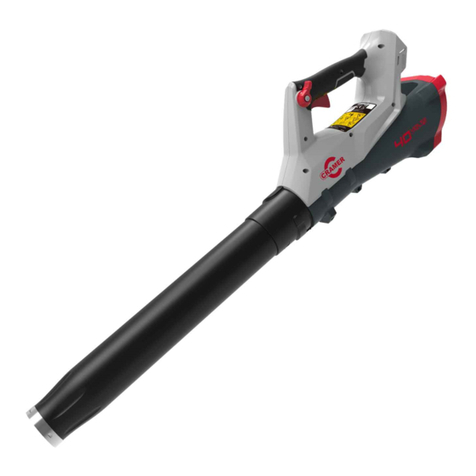
Cramer
Cramer 40B730 User manual

Cramer
Cramer 2400186 User manual

Cramer
Cramer 2400386 User manual
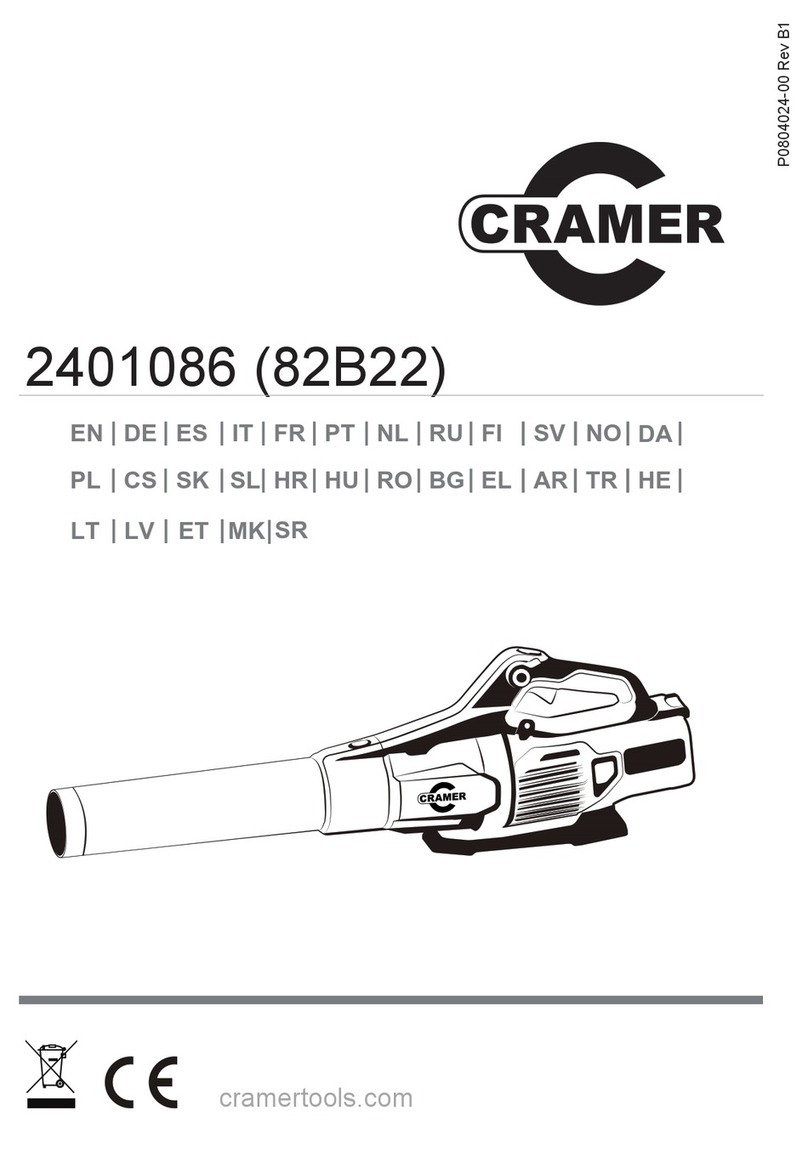
Cramer
Cramer 2401086 User manual
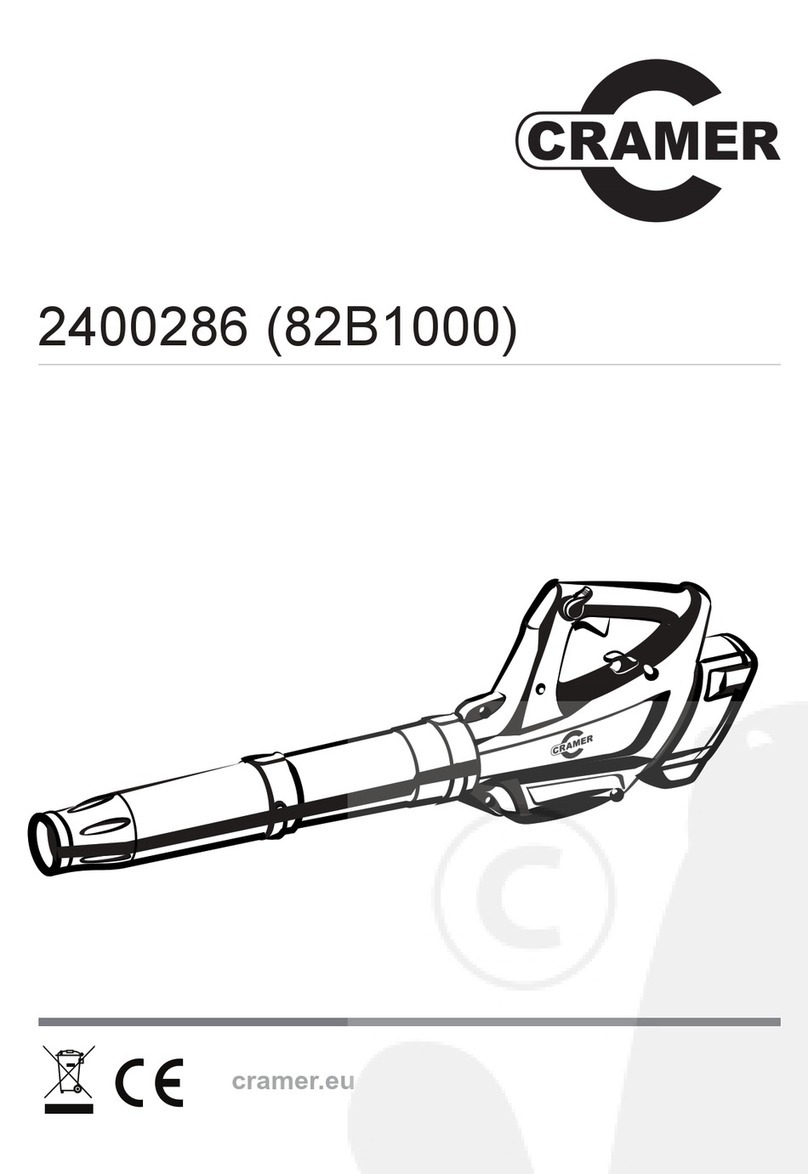
Cramer
Cramer 82B1000 User manual

Cramer
Cramer LS 5000 XP User manual
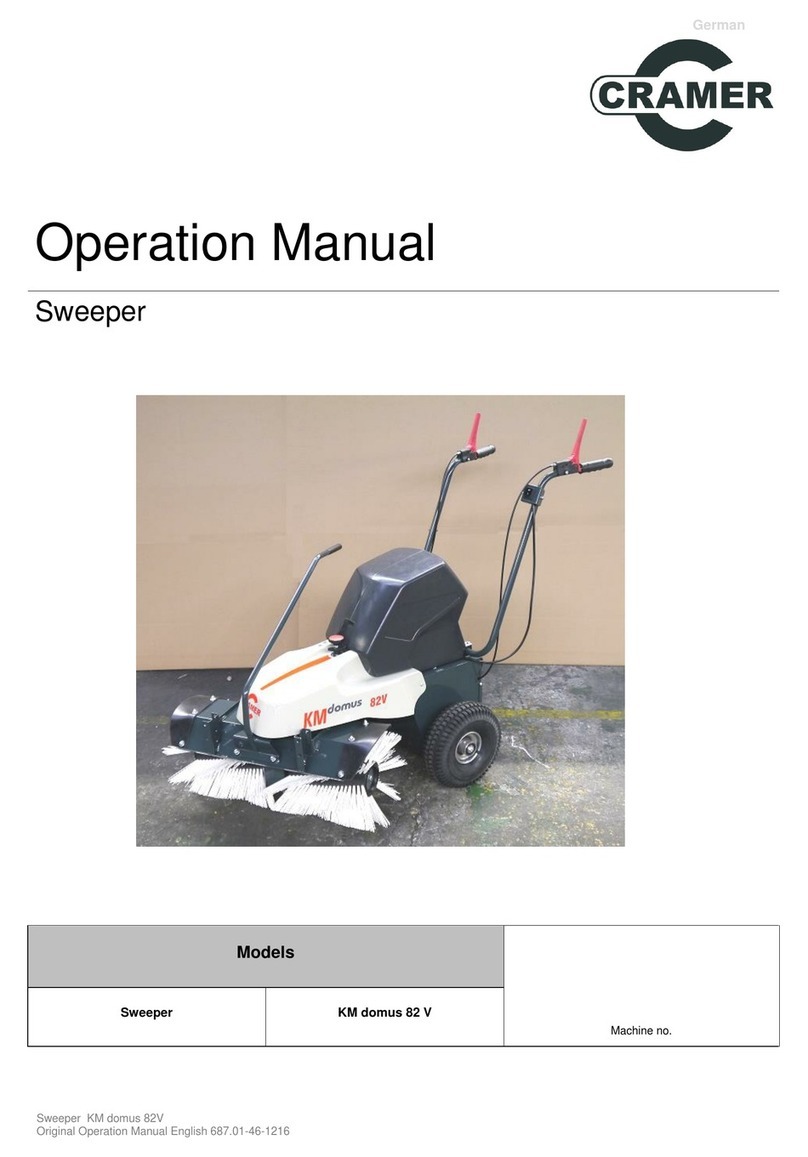
Cramer
Cramer KM domus 82 V User manual
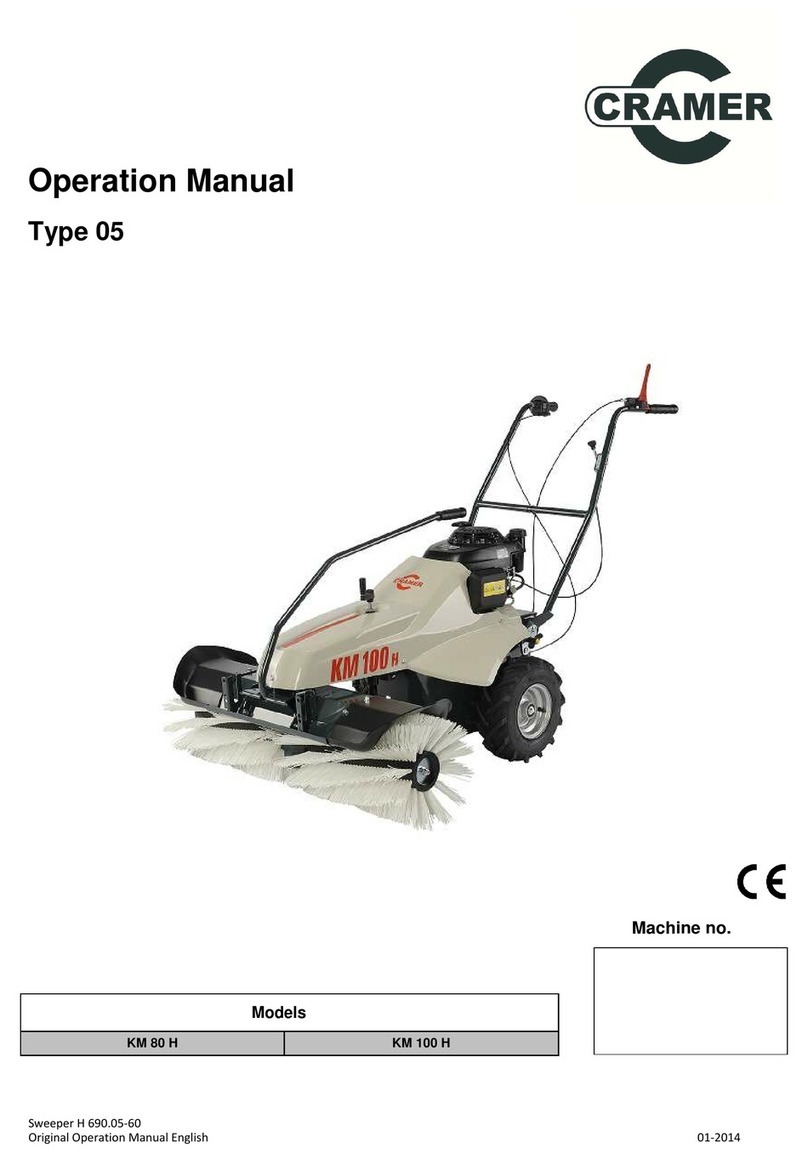
Cramer
Cramer KM 80 H User manual

Cramer
Cramer KM domus 82 V User manual
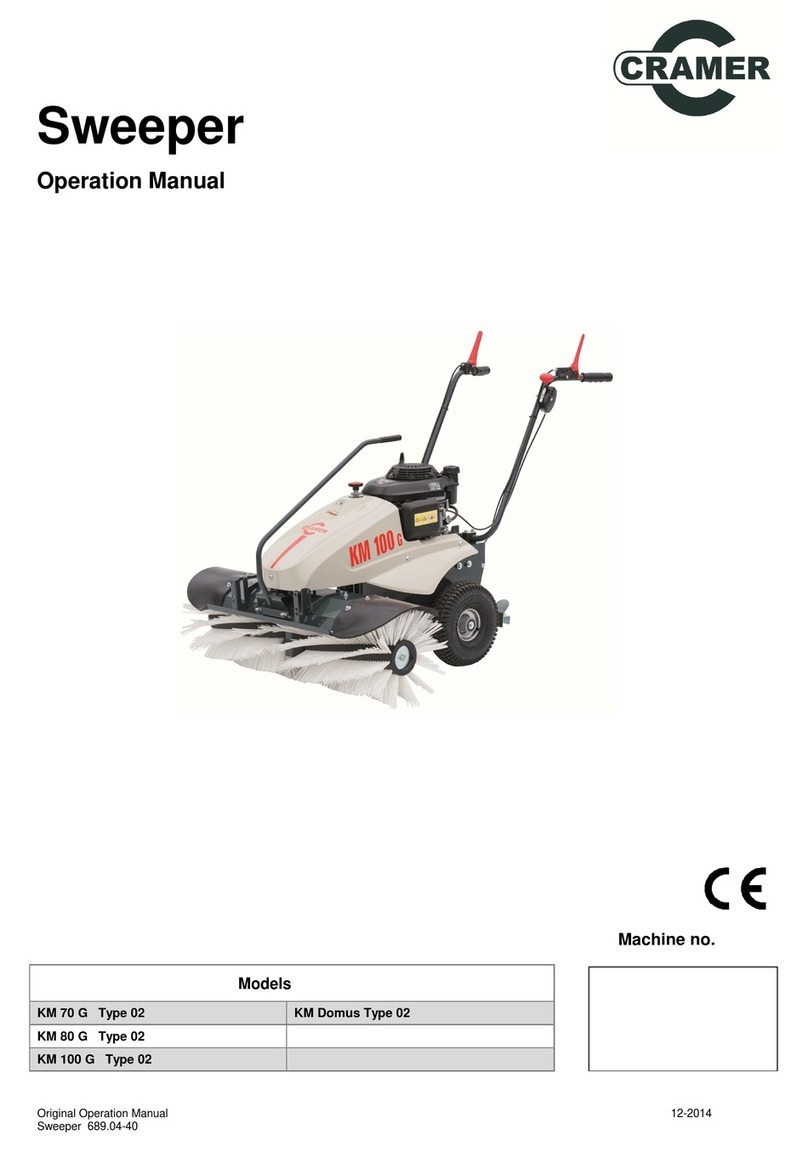
Cramer
Cramer KM 70 G Type 02 User manual

